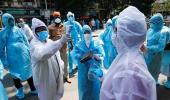Epidemiologists worry there's little or no data being shared on mortality by age group and contacts traced, which makes it difficult to understand how the effects of Covid-19 might be different in the Indian population, reports Ruchika Chitravanshi.

As the cases of coronavirus began to rise in Delhi, the information in the state’s daily health bulletin began to shrink, too, with details of ventilators or intensive care use beginning to disappear from mid-June. The bulletins also stopped providing the age break-up of patients. In fact, on some days in May and June there was no health bulletin at all.
Since early May, the Union health ministry began to share Covid-29 numbers only once a day, and since June 11, it has discontinued regular press briefings to give updates on the pandemic and answer critical questions.
Epidemiologists worry that the insufficient data on Covid-19 being shared by the health ministry, state governments and the Indian Council of Medical Research may impede the fight against the pandemic. The ICMR gives information on the total number of tests done the previous day and also the cumulative figure, but does not break it up by state or city.
The health ministry, too, only provides information on active cases, discharged cases and deaths in each state on a given day.
Again, there is no current information on the age-group or risk profile of Covid-19 patients who are in ICU or on ventilators or the number of asymptomatic or pre-symptomatic patients.
“We have no idea of mortality by age bracket across different regions of India. Scientists outside ICMR should have had full access to the serological data to understand regionwide spread and to analyse the accuracy of the numbers and make estimates of the infection fatality rate,” said Gautam Menon, professor of computational biology and theoretical physics, Ashoka University.
The ICMR is yet to release the findings of its second serological survey, which studied the spread of the disease in containment zones in the hotspot districts. The first serological survey showed that the infection was present in 0.73 per cent of those tested.
Scientists are also critical of the way this data was presented. “No scientist gives an average of the data. You first give the range and thereafter you can state the average,” a senior virologist said.
Another important detail missing from the data is the infectiousness of Covid-19, or its effective reproduction number. Among the patients already identified, it is not known how many infections were imported or locally acquired.
“We don’t know when, since they came in contact with the infected person, they contracted the infection... This is valuable data since it tells us what our quarantine and contact tracing rules should be,” said Rakhal Gaitonde, professor, Sree Chitra Tirunal Institute for Medical Sciences and Technology, Thiruvananthapuram.
The Centre has not shared any data on the contacts that were traced and how many of them tested positive. “Unless all the (state) governments put out this data, we will not have an idea on the transmission dynamics,” Gaitonde said.
Why is the data important?
Experts feel countries that provide more extensive data can calibrate their health system response better and make predictions, both in the short and the long term. For example, data on SARI (severe acute respiratory infections) and ILI (influenza like illness) and the total number of deaths due to these now and historically, can help calculate departures from historic numbers and quantify excess deaths or illnesses beyond the expected normal for the season. “We’re not doing our homework. Our singular purpose right now is: House is on fire, put the fire down,” said virologist Jacob John.
John’s predictions for Covid-19 in India are based on the number of deaths. “Total deaths is the only reliable number since you cannot contest that these people died of Covid,” he said. However, many Covid deaths are not getting medically reported or being attributed to respiratory or ILI.
India’s 2.8 per cent fatality rate, which is calculated as a percentage of total cases, does not give a correct picture either. Bhramar Mukherjee, professor of epidemiology, University of Michigan, said the fatality rate should be based on age-structure and closed cases. “Death plus recovered should be the denominator, instead of total cases,” she said. By this calculation, India’s fatality rate would be around 4.5 per cent.
Epidemiologists warn that unless there is better data, there would be no way of understanding how the effects of Covid-19 might be different in the Indian population.
So far, the government’s focus has been on the doubling time, the number of cured or discharged patients, and a lower fatality rate compared to other countries. Experts say this is not useful for planning hospital capacity and needs. “You need a predicted number of active confirmed cases in a day or weeks for a region so that you can anticipate that a fraction of them will end up in hospitals and ICUs and will need ventilators,” said Mukherjee.
Why does India lack data?
Experts say the gaps in data arise out of a lack of capacity as well as transparency on the part of governments. “Policymakers are seeing these numbers as an evaluation of their performance. This is unproductive,” Gaitonde said.
The competition between states is also counter-productive. State-wise resources differ, which accounts for disparities in the way numbers are reported. “Reporting of data depends on the individual public health capacities of different states.”
Experts feel the only way to reduce the uncertainties that surround the pandemic would be to use the data from our own experience and other countries.











